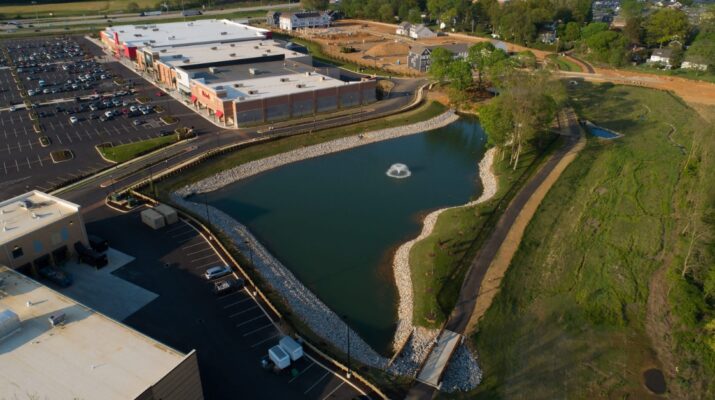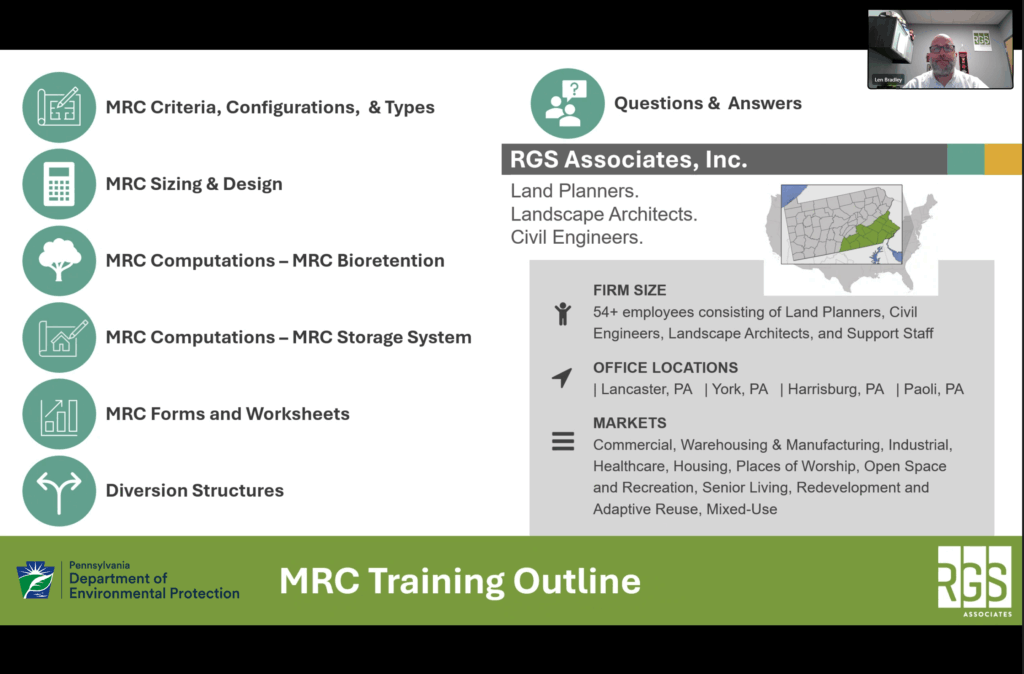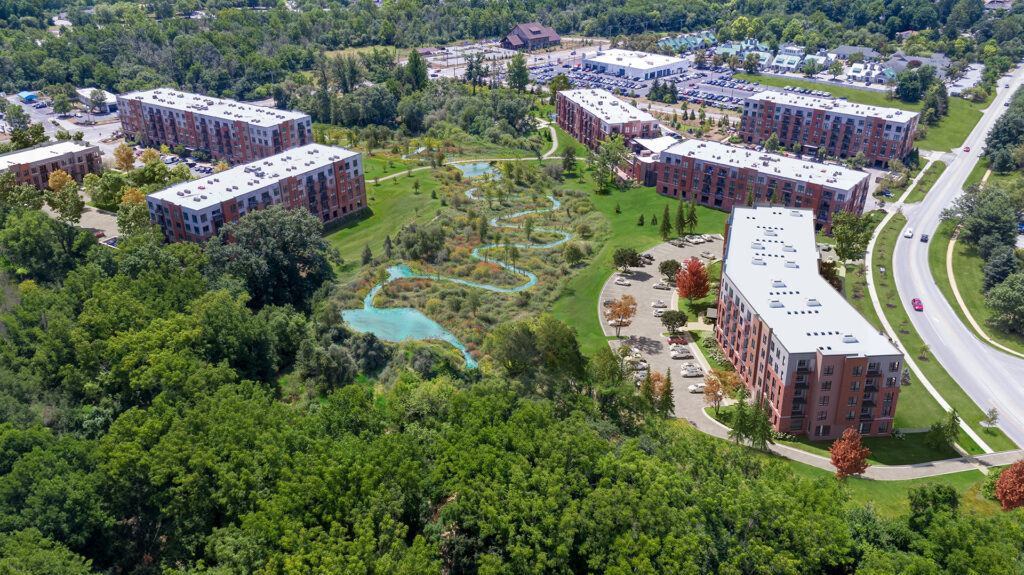From Vision to Outcome in Pennsylvania’s Regulatory Landscape

You can have the perfect site, the perfect concept, even the perfect design solution, but without the right guidance through Pennsylvania’s complex entitlement and permitting maze, a project can stall before the first shovel ever hits the dirt.
At RGS Associates, we understand that great design is only part of the story. The real magic happens when vision meets execution. From zoning challenges and environmental permitting to navigating layers of municipal, state, and federal review, anticipating regulatory roadblocks and building consensus are the key components to project success.
The Pennsylvania Permitting Challenge

Len Bradley, PE, Principal at RGS, has plenty of experience working through regulatory red tape.
“Describing the land development entitlement process in Pennsylvania as ‘complicated’ would be an understatement,” Len said. “There are multiple agencies involved, each with their own priorities, timelines, and formats. It’s our job to help connect all the dots.”
Len’s ability to connect those dots has earned him the attention and respect of state regulators. He was recently invited by the Pennsylvania Department of Environmental Protection (DEP) to provide training to department staff and county-level reviewers on best practices related to stormwater design and permitting. The goal of the training was to help clarify regulatory expectations and improve consistency in reviews across the state.
Collaboration Over Competition
Rather than keeping this knowledge internal, Len and the RGS team have been committed to sharing insights that support better communication and outcomes for everyone involved in the review process. Taking a more collaborative approach helps strengthen relationships with regulators and contributes to a more predictable path for clients working through complex approvals.

Whether it’s restoring a floodplain in Exton, guiding senior living communities through complex municipal approvals, or preserving 19th-century lime kilns within a thriving retail center, RGS approaches each project with a fundamental principle: facilitating outcomes.
Rather than simply designing beautiful spaces, good planners serve as both creative designers and strategic advocates to help clients navigate the regulatory maze that stands between vision and reality.
Getting to “Yes”
Pennsylvania’s land development approval process involves multiple layers of review, each with distinct requirements, timelines, and priorities. For example, a single project might require approvals from:
- Local municipalities for zoning and land development
- Conservation districts for erosion and sediment control
- Pennsylvania Department of Environmental Protection (DEP) for stormwater management and environmental permits
- Pennsylvania Department of Transportation (PennDOT) for highway occupancy permits
- Federal agencies for wetlands or floodplain work
The number of approving bodies is just one of the hurdles. The biggest barriers are the coordination required between these bodies and the varying interpretations of regulations across different jurisdictions.
“One of the many challenges of land development is navigating this process while maintaining the project schedule and meeting client expectations,” Len said. “Over the years, we have found success through a balance of science, planning, and diplomacy.”
Early Coordination Lays the Groundwork

Another critical factor in achieving successful outcomes is the early integration of regulatory requirements into the design process. Too often, stormwater management and environmental considerations are treated as afterthoughts, leading to costly redesigns and schedule delays.

This philosophy proved essential for the Keva Flats project in Exton, where RGS helped The Hankin Group navigate one of Chester County’s first major floodplain restoration projects. The approach required coordination with DEP’s central office, the U.S. Army Corps of Engineers, and West Whiteland Township.
“I was nervous about the timing,” said Neal Fisher, Vice President of Development at The Hankin Group. “It actually went much quicker than I thought.”
The key to success was involving regulatory agencies early in the design process and presenting well-prepared plans that clearly communicated the project’s environmental benefits. The NPDES permit approval process took approximately 18 months from submission to approval, which was an efficient timeline for such a complex project.
Creating Partners, Not Adversaries
RGS Associates’ perspective on regulatory relationships is built on a fundamental premise: treating regulators as partners, not impediments.
“Beyond the technical aspects, navigating the regulatory landscape is a relationship business,” Len said. “Developers and consultants should approach regulators as partners in their project rather than as adversaries.”

This partnership concept was crucial at The Shoppes at Belmont, where RGS helped Waters Retail Group integrate historic preservation elements into a complex mixed-use development. The project required creative solutions to preserve lime kilns, historic stone piers, and even a family graveyard dating to the 1880s, while maximizing retail space.
When additional lime kilns were discovered during construction at Belmont, RGS worked closely with township officials to redesign a primary road, preserving the historic features while maintaining the project’s functionality. This collaboration between planner, developer, and municipal officials turned a potential obstacle into a unique community amenity.
The Art of Clear Communication
Beyond technical expertise and relationship building, successful permitting often comes down to clear communication. The way information is presented can often be just as important as the information itself.
“There is no substitute for a well-thought-out and concise design,” Len said. “The project’s design, plans, applications, and reports need to be clear and easily understood by the decision makers. Presenting the necessary information in the format requested will help the regulators remain focused on what is important and help expedite the review process.”
Strategic Flexibility and Client Advocacy
Part of facilitating outcomes involves knowing when to advocate strongly for a client’s position and when strategic flexibility serves the project better.
Sometimes, regulators request changes that fall outside the original scope. RGS helps clients weigh the long-term value of conceding versus pushing back. Very often, strategic compromise can lead to faster approvals.
This doesn’t mean compromising on important project elements. Instead, it involves understanding which battles are worth fighting and which concessions can actually improve long-term outcomes.
The Value of Experience
With over 30 years of experience in Pennsylvania’s regulatory environment, RGS Associates brings institutional knowledge that can save clients significant time and money. Our experience includes understanding the nuances of different municipalities, building relationships with key regulatory personnel, and knowing which strategies work in various situations.
A combination like this is particularly valuable when projects face unexpected challenges. Whether it’s discovering wetlands during a site investigation, addressing neighborhood concerns during public hearings, or adapting to changing regulatory requirements, experienced professionals can help projects stay on track.
Moving Forward with Confidence
The path from vision to approval is rarely simple, but with early planning and experienced guidance, even the most complex projects can succeed.
“Having honest conversations with our clients and the regulatory agencies at the beginning of each project, to review project goals and to establish an understanding of expected outcomes, can provide a road map to better navigate through the approvals process,” Len said.
In Pennsylvania’s complex regulatory environment, that roadmap can make the difference between a project that thrives and one that never gets off the ground.




